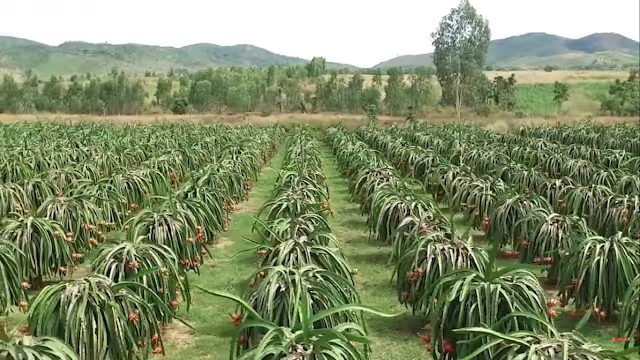Dragon fruit, also called Pitaya is one of the rare yet profitable crops in Kenya. The tropical fruit which belongs to the cactus family is known for its vibrant colors and unique taste.
Just like any other fruit, dragon fruit comes in various varieties including the Hylocereus Undatus (pink-green scales), Hylocereus Costaricensis (pink), and the Hylocereus Megalanthus (yellow).
The pink-green scales variety is the most popular in Kenya and around the world markets and features a striking pink or red skin with prominent green scales.
The flesh inside is usually white, peppered with tiny black seeds. This variety is mildly sweet and has a texture often compared to kiwifruit. It’s refreshing, with a balance of sweet and tart flavors.
According to Forestry.com, pink-green scales dragon fruit adapts well to a range of climates but prefers tropical or subtropical environments. It’s relatively tolerant of colder temperatures compared to other varieties.
On the other hand, the pink variety is pink in colour with vibrant red or purple flesh, while yellow dragon fruit features yellow skin and white flesh.
Before investing in any dragon fruit variety, it is advisable first to consider climate sustainability and market preferences.
Six most profitable crops per acre that have made several Kenyans millionaires
The pink-green scales variety is more versatile in different climates, whereas the pink and yellow varieties prefer hot and humid, and hot and dry climates, respectively.
In terms of uses, the pink fruit is excellent for adding color to dishes such as smoothies, desserts, and cocktails while the pink-green scales and yellow varieties are great for direct consumption due to their sweetness.
Planting dragon fruits
Dragon fruit can either be sowed from seeds or cuttings. Planting from cuttings is the most preferred method as it is not time-consuming.
It will take 1 to one and a half years for a dragon fruit vine to produce the first fruit if it is planted from the cutting of a mature vine.
A vine propagated from a seed will on the other hand take more than 6 years to mature. The lifespan of dragon fruit plants is over 40 years and the plant can produce fruits more than twice a year.
In addition, cuttings are generally easier and more reliable to grow as they are less susceptible to environmental variables compared to seeds.
The plant can grow in any soil that is well-draining. However, soil that is slightly acidic with a pH level that is between six and seven would be better.
How to grow carrots in your small farm.
Watering and fertilization
Even though dragon fruit does not require a lot of water, irrigating it when the top of the soil is dry is advisable.
Use a drip irrigation system or water by hand to avoid wetting the foliage, as this can increase the risk of fungal diseases.
Watering early in the morning is ideal as it allows excess water on the surface to evaporate during the day.
Additionally, give the plant a little fertilizer every month during its active growing season. Use a balanced, all-purpose fertilizer with an equal ratio of nitrogen, phosphorus, and potassium.
Organic options like compost or well-rotted manure can also be beneficial. Observe your plant for signs of nutrient deficiency or excess.
The signs that the plant needs more nutrients include slow growth, poor flowering, and weak fruit production. Overly lush foliage with little fruiting can on the other hand suggest excessive nitrogen.
Support structures
Dragon fruit plants further require a support structure to aid growth and fruit production. Support structures further help in the control of pests and diseases and allow for easier access to the fruit without damaging the plant.
Steps to growing quality onions for maximum profits
Prune your dragon fruit plant just before the new growth starts to promote growth and fruit production. Remove dead or excessive growth to encourage air circulation and sunlight exposure.
Pests and diseases
While the dragon fruit plant is very tolerant to diseases, common pests such as aphids, mealybugs, and ants can be destructive.
Use biological methods and organic pesticides to control pests, and ensure good air circulation, and avoid overwatering to prevent fungal diseases.
Harvesting and yield per acre
The fruit is usually ready for harvesting when its skin color changes and the wings on the fruit start to wither. In addition, when the fruit is easy to pluck from the vine suggests ripeness.
You can keep dragon fruits for up to 18 days after harvesting without refrigeration. Under proper refrigeration, the fruit will remain fresh even for 3 months.
This fruit is not perishable since it stops ripening immediately after it is cut off from the mother plant.
According to experienced farmers, this exotic fruit can yield an average of 6500 kg per acre during the first two years of growth and assuming a plant population of 2400 plants.
As the tree progresses, the yield increases to 10,000 to 12,000 kg per acre. Each dragon fruit is normally around 300 – 1000 grams in weight.
Market price
In the current market, a single fruit fetches between Sh. 400 and Sh. 600 during the low and high seasons, respectively.
The weight of a single fruit is an added advantage, as three fruits are sufficient to make a kilogram. One kilogram can sell for up to Sh. 1500.
The main reason why the fruit is so expensive is the low supply against a high demand. The supermarkets that stock these fruits in Kenya rely on imports from other countries.
This presents a great opportunity for farmers who would want to invest in dragon fruit farming in Kenya.








